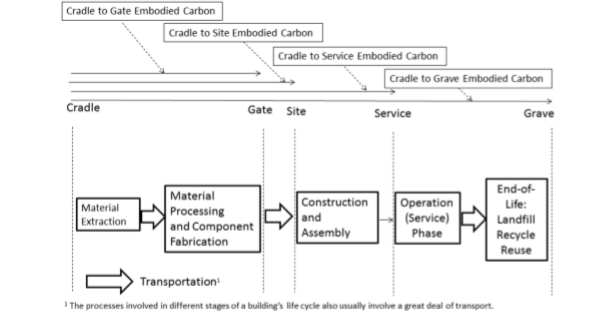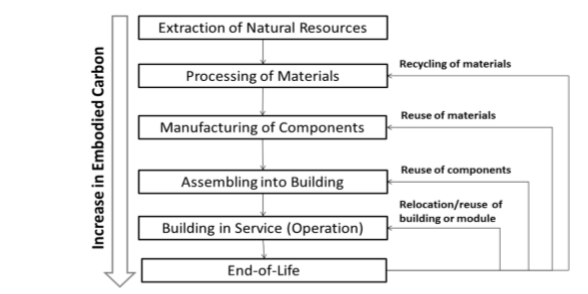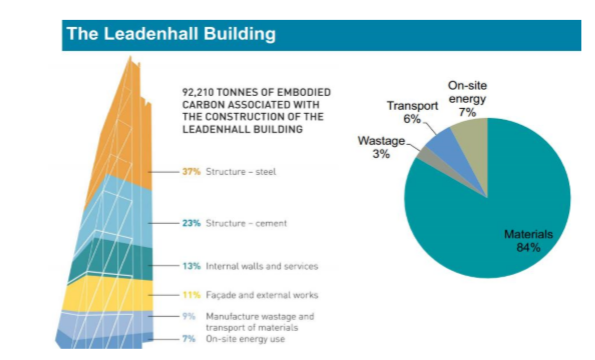Reduction of Carbon in Construction, Research Paper Example
Abstract
Research done by the UK Green Building Council indicates that construction makes a 30-percent contribution towards the global greenhouse gas emissions (GHG) on an annual basis. These emissions are usually reported as common or somewhat equivalent to carbon units. The discharge of carbons usually occurs in every stage of the building’s life cycle. As such, the emissions are categorized as operating carbon and embodied carbon. Each of these categories usually makes a formidable contribution towards the lifecycle of carbon, which depends on the characteristics of buildings and the materials used. Building and construction have been improving as technology changes. Some of the most recent advances include reducing operating carbon of buildings with researchers focusing their attention towards minimizing embodied carbon.
Nevertheless, reduction of embodied carbon of buildings had experienced challenges since it requires a thorough evaluation of the effects which could be felt upon reducing embodied carbon in buildings and other constructions. Therefore, this research focuses on the strategies adopted concerning reducing embodied carbon and the methods utilized to help estimate buildings’ embodied carbon. Research also focuses on reviewing the strengths as well as weaknesses of every method adopted. The study will also evaluate how builders minimize consumption of water of a house as well as designing a home and its environment to deal with climatic changes such as rainfall in Qatar.
Discussion
A building has several stages in its lifecycle, all of which differ in their use of energy and emission of carbon. These factors are defined by the extraction of materials, processing of materials, the fabrication component, assembly and construction, service phase and operation, and the end-of-life phase. Additionally, there are transitions between these phases, which involve the high level of emissions resulting from transportation. This emission should be part of the carbon footprint estimation. Research done by Ali Akbarnezhad and Jianzhuang Xia shows that there are two general groups concerning the categorization of carbon emissions: operating carbon emissions and embodied carbon emissions.
The Life Cycle of Building Materials
(Adopted from Omer, 2008)
The use of a building, however, may lead to variance in carbon emission from building other factors affecting the embodied carbon emissions, including the location of the building, the climate in the area, the type of the fuel used the building orientation, and the building massing, and many more. As such, there is a variance concerning the share of embodied carbon emitted by the building and construction of conventional buildings, which can be as low as 20 percent. Buildings that operate as offices and residential buildings can be as high as 80 percent (Marszal et al., 2011). Buildings designated as low energy such as washhouses have even higher amounts. However, technology is rapidly changing, and effective ways to ensure there is a reduction in embodied carbon is being discovered. Some of these ways include advanced energy efficiency means and stringent energy efficiency ways due to requirements by climate regulatory agencies. Measures to curb increased carbon emissions are being developed and introduced to the building and construction industry to reduce carbon emissions, contributing to global warming. Therefore, a combination of the embodied energy and embodied carbon share has been closely linked hence bringing the total share up to 50 percent (Marszal et al., 2011). Due to this concern, strategies to ensure the reduction of embodied carbon emissions from buildings and construction operations are being introduced. One of the main challenges, however, remains to be the effectiveness of these strategies since they have to be tested and proven to ensure that there are no residual dangers.
Low carbon materials
The research indicates that designers have been obliged to select from several alternative materials available to them for every element, either structural or non-structural (Xing, Hewitt, and Griffiths, 2011, p 61). The also obliged to consider the performance of the elements against any technical requirements to ensure that they meet the purpose while at the same time assuring carbon reduction. According to research done by Institution of Civil Engineers (ICE), there are shortlisted materials, all of which have different levels of embodied carbon, which are considered considerable and which meet technical and performance requirement criteria (Xing, Hewitt, and Griffiths, 2011, p 66). Depending on the composition of the material type, quarries location from which the materials were extracted, the transport mode used, the intensiveness of carbon extraction, as well as the operations of processing the material, usually leads to variance in the levels of carbon in the materials (Xing, Hewitt, and Griffiths, 2011, p 66). Other factors affecting the level of embodied carbon in materials include how intensive the methods of construction, the intensiveness of the recycling and reuse processes, and the distance of the disposal sites which accept the resultant waste. Research done by Gonzalez and Navarro lecturers at the University of London indicated that there had been a decrease of 30 percent of carbon emission which has been achieved through the replacement of conventional materials with materials which have a lower embodied carbon (Xing, Hewitt, and Griffiths, 2011, p 66). The strategy is to ensure that the carbon footprint for buildings and construction has been reduced and possibly eradicated. However, in replacing the materials, there should be a consideration of the effects associated with the alternative materials to prevent which should be done through a comparison with the type of material (Xing, Hewitt, and Griffiths, 2011, p 66). Such variations usually cause a variance that is experienced due to transportation, construction as well as the requirements which are needed during the processing at the end-of-life of the different materials. The type of materials usually affects the requirements of the operating energy in some buildings, which, therefore, introduces the need to assess the effects that the building’s working carbon may have due to the change of materials. Hence, the selection of materials processing results should be considered.
Dimoudia did further research, and Tompa lecturers from the University of London also indicated that structural reinforcement such as steel and concrete have the highest share of embodied energy, which accounts for 55 percent of the entire embodied energy a building has (Hui, 2010, p 56). Choosing the materials to use can, however, affect the embodied carbon of the building. In addition, the grade of the concrete, as well as the reinforcement bars, can change the structure as well as the embodied carbon to about 40 percent (Hui, 2010, p 59). The researchers also indicated that when different structural materials are used either steel, concrete, or wood, the difference in embodied (Hui, 2010, p 60). Carbon and energy change drastically since all the materials have a huge difference concerning the composition of the materials.
In most cases, the best-recommended process to choose low carbon materials is to use the minimum cradle to gate (Hui, 2010, p 65). However, these processes have been found to have shortcomings since the intended result, which is attaining the lowest life cycle of carbon footprint, is not always achieved. The most recommended material for building construction is wood since it has the smallest amount of embodied carbon compared to concrete and steel. Wood is also recommended since it has the lowest energy-intensive process of manufacturing. According to Monahan and Powell, some countries have made substantial progress regarding the reduction of embodied carbon through embracing building and construction using wood (Monahan, and Powell, 2011, p 23). The United Kingdom, for example, had made tremendous steps such an increase of 17 percent in the usage of wood as construction materials hence reducing embodied carbon emission by 2 percent (Monahan and Powell, 2011, p 23).
The existing materials with high amounts of embodied carbon can also be reduced through the use of waste, recycled materials, or even byproducts while making the materials. This helps reduce the embodied carbon in the materials (Strain, 2017, p 34). Cement and concrete are the most common construction materials which have the highest embodied carbon. However, this can be reduced through the use of waste and recycled materials while making concrete (Strain, 2017, p 37). The use of recycled materials and waste should only be partial. This process has been emphasized more than other means due to the extensive use of concrete, which poses a considerable problem for the entire world. It has made the emission of embodied carbon global and at high rates. Some of the materials recommended as partial substitutes while manufacturing cement include ash, amorphous silica, silica fumes, and ground granulated blast furnace slag. Portland cement has adopted this process, where it partially uses supplementary cementitious materials.
Further research done by Marc Huninilowyez, a lecturer at the University of Sussex, indicates that more ways and materials can be used as an alternative to building and construction materials with high embodied carbon (Strain, 2017, p 39). Materials such as hydraulic cement as well as geopolymer concrete have low amounts of carbon. The research indicates that these materials have been widely advocated to ensure that Portland cement has been replaced. The two researchers indicted that geopolymer cement has resulted in an 80 percent reduction in embodied carbon as compared to emission by Portland cement. “The reaction of aluminum and silicon combined with byproduct materials such as ground granulated blast furnace slag, ash from rice husk, and an alkaline liquid helps in forming a cement-like binder” (Strain, 2017, p 44). However, the aspects of geopolymer concrete are working progress with its extensive negativity still unknown. It is undoubtedly confirmed that “geopolymer concrete is better than the Portland cement regarding elasticity, compressive strength, shrinkage, tensile strength, creep, corrosion resistance fire resistance, acid resistance, and sulfate resistance “(Strain, 2017, p 47).
Material minimization
Marc Huninilowyez, in his research, indicates that, “the total embodied carbon of a building or any structure is directly proportional to the material quantities in the building” (Venkatarama, 2009, p 18). As such, comparing the materials to be used as alternatives, the total embodied carbon should be considered, which can be done by evaluating the unit rate of the product for embodied carbon as well as the aggregate material quantity which has been used in the building or structure. As indicated, the material composition can affect the entire structure’s integrated carbon composition (Venkatarama, 2009, p 19). The material quantity can also change the structural system of a building as well as its height. Researchers also indicated that the optimal design should be advocated for rather than the overdesign, which since it helps in the reduction of the total quality materials reduces embodied carbon. Overdesign is discouraged since it is a way of minimizing the cost of construction by reducing the weight of the materials used, therefore compromising the quality of materials. Inferior materials of construction have the highest amount of embodied carbon. Nevertheless, as the reduction of embodied carbon is considered through the minimization of materials used, the contractors should ensure that the ability of the structure concerning meeting the performance and technical requirements should be guaranteed to avoid losing the structural integrity of the building. Reduction of the generated waste when production of construction is underway has been found to have considerable potential in minimizing the embodied carbon.
Materials recycling and reuse
Upon turning construction elements into a structure, the embodied carbon usually increases upon an increase of consumed energy, which takes place every step and every stage of the building’s lifecycle. As such, as the materials of construction undergoes through the processes of manufacturing, processing, assembly, and installation, they acquire a certain amount of embodied carbon (Venkatarama, 2009, p 29). However, the worst stage is when the building has reached the last step. It is of no more use since the concentrations of embodied carbon are high, and more the means of disposal of the materials leads to massive emission of embodied carbon into the air. Some of the recommended processes of dealing with a building after it reaches its end of service included demolition landfilling as well as reuse and recycling of the materials. The embodied carbon of buildings that have reached the end of service, according to the cradle to the grave, should be accounted for primarily due to the after-effects of the emissions. As such, between the two end-of-life strategies, demolition and landfilling leads to increased emission of embodied carbon as compared to recycling and reuse of the materials. Nevertheless, the recyclability of the materials has to be assessed before opting for the option.
Increase in Embodied Carbon
(Adopted from Venkatarama, 2009)
Construction optimization strategies
During construction, the operation process, especially the equipment used, has a high emission rate of the embodied carbon. Dimoudia and Tompa’s research indicated that carbon emission at this stage could easily be minimized through several approaches. Optimization of the operations during construction ensures reduction of the idle time of the equipment, selecting construction equipment’s optimal, optimizing the process of the equipment, and minimizing transport onsite (Venkatarama, 2009, p 39). As far as optimization is concerned, there is no supporting literature indicating that optimization of some construction operations such as concreting, onsite transport, and lifting has any effect on reducing embodied carbon. However, the optimization of these operational
Material Used in the Leadenhall Building
(Adopted from Venkatarama, 2009)
The diagram above shows the proportions of embodied carbon as represented in the Leadenhall building’s different elements.
In Qatar, buildings are responsible for more than 20 percent of the State’s energy-related greenhouse gas emissions hence being a massive contributor to climate change. Some emissions are experienced through the use of fossil fuels, which are primarily used in the majority of homesteads. Due to climate change, therefore, changes such as heavy rainfall, strong winds, high temperatures, rising seas as well as other extreme climatic patterns are being witnessed within the State. This has introduced a debate of ensuring that buildings are built strong enough to withstand such extreme climatic conditions. To withstand high temperatures, for example, buildings use fridges, energy-efficient stoves to lessen internal heat gains, use external shading, reflective gazing, and reflective rooftops. Contractors are also using natural ventilation, green roof design, as well as installations of whirlybirds to eradicate heated air from the cavity of the roof. For heavy rainfall, contractors use models that do not allow embers to be caught in the ceiling. Storms and cyclones are being countered using building designs that minimize the load of the wind. The use of materials that are impact resistant for any external cladding and using waterproof materials as well as those that are well designed to handle drainage, especially vents, flashing, and penetrations.
Recommendations and Conclusion
One of the recommendations for choosing the best materials is chosen. The reduction of embodied carbon in buildings and construction is selecting the best structural materials and a system to ensure the reduction of embodied carbon. When selecting such materials, research indicates that “it should be based on the effects of the structural system on the life cycle carbon footprint and not the carbon footprint of the individual life cycle”( Falk, 2010, p 21). This research has focused on ways in which to reduce embodied carbon in construction and buildings. Despite efforts made to ensure that structure is free of embodied carbon, the emission is still a considerable concern, especially with the rising cases of global warming, which has led to massive adverse effects of climate change. The use of low carbon materials, reuse, and recycling, as well as mineralization of materials, are just. A few ways are highlighted in this research, which has shown positive results regarding the reduction of embodied carbon in buildings (Falk, 2010, p 29). However, some of the concerns are the effects that are attributed to some of these strategies. The reduction of materials has been noted to have a significant impact on the building’s structural integrity. Reuse and recycling can only be considered if the residual materials are worthy of being recycled and reused. If they are in a worse state, the only alternative is the emission of the embodied carbon.
Bibliography
Falk, R.H., 2010. Wood as a sustainable building material. Wood handbook: wood as an engineering material: chapter 1. Centennial ed. General technical report FPL; GTR-190. Madison, WI: US Dept. of Agriculture, Forest Service, Forest Products Laboratory, 2010: p. 1.1-1.6., 190, pp.1-1. Available from: https://www.fs.usda.gov/treesearch/pubs/download/37431.pdf
Hui, S.C., 2010. Zero energy and zero-carbon buildings: myths and facts. In Proceedings of the International Conference on Intelligent Systems, Structures, and Facilities (ISSF2010): Intelligent Infrastructure and Buildings. Asian Institute of Intelligent Buildings (AIIB). Available from: http://ibse.hk/cmhui/ISSF2010-SamHui.pdf
Marszal, A.J., Heiselberg, P., Bourrelle, J.S., Musall, E., Voss, K., Sartori, I., and Napolitano, A., 2011. Zero Energy Building–A review of definitions and calculation methodologies. Energy and Buildings, 43(4), pp.971-979. Available from: http://www.academia.edu/download/39255074/542a91fc0cf277d58e87457f.pdf
McGregor, A., Roberts, C., and Cousins, F., 2013. Two degrees: The built environment and our changing climate. Routledge. Available from: https://books.google.com/books?hl=en&lr=&id=2RKrF4b_zMsC&oi=fnd&pg=PP1&dq=how+builders+can+minimise+the+water+consumption+of+a+house+and+design+a+house+and+its+surroundings+to+deal+with+rainfall+and+any+other+climatic+conditions+in+the+State+of+Qatar.&ots=WIfSKyfms6&sig=1WYL4aDVJuTO8lfzUWeEVhjxyn4
Monahan, J., and Powell, J.C., 2011. An embodied carbon and energy analysis of modern construction methods in housing: A case study using a lifecycle assessment framework. Energy and Buildings, 43(1), pp.179-188. Available from: https://www.sciencedirect.com/science/article/pii/S0378778810003154
Omer, A.M., 2008. Energy, environment, and sustainable development. Renewable and sustainable energy reviews, 12(9), pp.2265-2300. Available from: http://5pr.kpk.gov.pl/prog_tem_4b/dokumenty/db_pg2_en_200002.doc
Ostrom, E., 2009. A polycentric approach for coping with climate change. The World Bank. Available from: https://pdfs.semanticscholar.org/9997/8f9cf79a05a66b6939be325f391368bc707c.pdf
Pastrana-Ayala, J., Silva-Urrego, Y., Adrada-Molano, J. and Delvasto-Arjona, S., 2019. Propiedades físico-mecánicas de concretos autocompactantes producidos con polvo de residuo de concreto. Informador Técnico, 83(2), pp.174-190. Available from: http://revistas.sena.edu.co/index.php/inf_tec/article/download/2170/2655
Strain, L., 2017. 10 steps to reducing embodied carbon. Available from: https://www.aia.org/articles/70446-ten-steps-to-reducing-embodied-carbon
Venkatarama Reddy, B.V., 2009. Sustainable materials for low carbon buildings. International Journal of Low-Carbon Technologies, 4(3), pp.175-181. Available from: https://scholar.google.com/scholar?output=instlink&q=info:0B-Gowd_VGAJ:scholar.google.com/&hl=en&as_sdt=0,5&scillfp=11723812564951082901&oi=lle
Xing, Y., Hewitt, N., and Griffiths, P., 2011. Zero carbon buildings refurbishment––A Hierarchical pathway. Renewable and sustainable energy reviews, 15(6), pp.3229-3236.

Time is precious
don’t waste it!

Plagiarism-free
guarantee

Privacy
guarantee

Secure
checkout

Money back
guarantee









